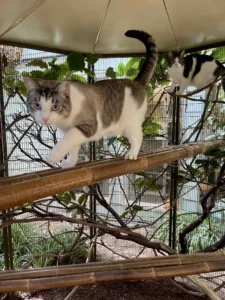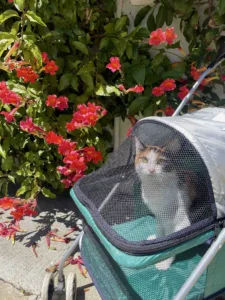Pet parents often ask if they should let their cat go outside. These pet parents seem to think that their cat “wants” to go outside and/or that cats are inherently suited for outdoor life. While ultimately it is the pet parent’s decision, there are several factors to consider before allowing your cat to freely roam the streets of San Francisco. Here are just a few:

- Traffic: Between cars, buses, light rail vehicles, trucks, and driverless cars, the streets of San Francisco are plenty dangerous for people, let alone for cats which are often less visible and potentially less cautious around vehicles. While there is no exact number of cats hit by cars in San Francisco, nationwide estimates suggest that up to 5.4 million cats get hit by cars a year.
- Predators: Although San Francisco is an urban area, there are still predators such as coyotes and birds of prey that pose a threat to outdoor cats. precise data on the number of cats that fall prey to coyotes or birds of prey is lacking, one only has to pay a bit of attention to social media or the news to hear these sad stories
- Disease and Parasites: Outdoor cats are more susceptible to various diseases, parasites, and environmental hazards. Keeping them indoors can mitigate their risk of contracting illnesses or becoming infested with parasites.
- Lost or Stolen: In a densely populated area like San Francisco, outdoor cats can easily get lost or even stolen. Staying indoors reduces the likelihood of them wandering off or being taken by someone.
- Noise and Stress: Urban environments can be noisy and stressful for cats, with loud vehicles, construction, and other disturbances. Keeping them indoors provides a quieter and safer environment for them to thrive.
- Reduced Veterinary Costs: Veterinary bills – they are certainly not cheap in San Francisco! Indoor cats are less likely to encounter injuries or illnesses associated with outdoor living, such as fights with other animals, parasite infestations, or traumatic injuries. Having your cat remain indoors is not only better for your cat’s well-being, it is the fiscally responsible thing to do!
- Longer Lifespan: Indoor cats typically live longer than outdoor cats. While outdoor cats may have a life expectancy of around 2 to 5 years, indoor cats can often live well into their teens or even early twenties.

Of course, if you and your cat want the best of both works, you can just visit Cat Safari and your cat can enjoy the Safari Solarium and Presidio Stroll.
Thanks for reading.
